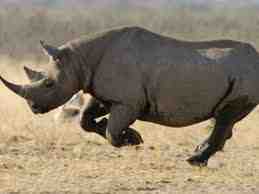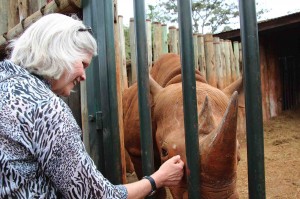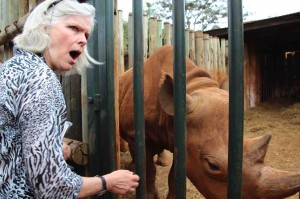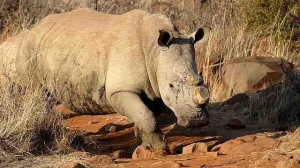
Rhinocerous have always appeared to me to be elusive, other-worldly beings. Most people, including me, who have been lucky enough to see a rhinoceros in the wild don’t usually speak about them with the same emotional furor used when talking about elephants, big cats or gorillas.
The rhino’s pre-historic coats of armor don’t inspire warm and cuddly feelings.
And, although I was always elated to see one on safari, the emotions were ephemeral, a result of understanding how rare the sighting was.

All of that changed when I met Max.
After reading Daphne Sheldrick’s book, Love, Life and Elephants, I visited her elephant orphanage in Kenya. Although the main attraction is the orphaned baby elephants, at the end of my visit there I noticed a large fenced in area separated from the elephants stalls.
Inside was an intimidating bulk of animal – a one-and-a-half-ton rhinoceros. “That’s Max,” one of the caregivers told me. “He’s blind.”
I approached the enclosure and stood next to the green metal gate. As soon as I began sending out a heart felt connection toward Max he turned and walked straight towards me from the opposite side of the enclosure.
PETTING A RHINOCEROUS
Two lethal looking horns projected from the front of his head as he maneuvered his body sideways against the steel bars that separated us.
I reached my hand through the slat. Doubting he could sense my touch through rhino skin that felt dry and gritty like sandpaper, I began to scratch. I rubbed around his face, ears, and cheeks.
His head sunk incrementally lower and lower toward the ground as his neck muscles gave way to my rhino massage.
And then he closed his eyes and moved towards my hand so that I was touching his belly. He wanted a belly rub.

Then I heard a long low sigh coming from deep inside of Max’s physical and emotional being.
Is he crying? I wondered.

Found blind and motherless, I learned that Maxwell was brought to the elephant orphanage at the start of 2007.
As I continued to stroke his belly I began crying.
Weeping for my lack of understanding of this magnificent animal, and for all the pain inflicted on his species.
RHINO POACHING CRISIS
About 1,000 rhinos are killed by poachers annually, and there are an estimated 25,000 left in the wild.
The poachings have a mafia-like level of sophistication, and the prices fetched ($133 per gram of powdered horn) equal profits rivaled in drug and sex trafficking.
The rhino’s horns are brutally hacked off their faces (fatally wounding the animals) and then shipped to Laos, China, and Vietnam where the horns are used as high-level gifts by governmental officials and other wealthy business people.

The crazy thing is, the horns are made of keratin, the same substance of our finger and toenails.
Good News for Rhino
On most of my Kenya safari itineraries I include the Lewa Wildlife Conservancy. The place started as a rhino sanctuary and has become a model of conservation worldwide. Working with the local communities in the area Lewa has had zero rhino poaching incidents for many years so tourists are basically guaranteed to see wild rhinoceros.
When I told Max’s caretakers at the Sheldrick orphanage that Max seemed to be crying while I caressed him, they replied, “No, no, he wasn’t crying. He was happy,” they said. “He loves to be touched and he especially loves to be tickled.”
Rhinos love to be tickled. The words flipped my heart and head around. But then I found myself asking, who doesn’t like to be tickled?
Since meeting Max the rhinoceros whenever I now see a rhino on my safaris I feel an emotional connection to the sweet, sensitive, misunderstood rhinoceros being.
****
WHAT YOU CAN DO TO HELP SAVE RHINO FROM EXTINCTION:
Donate to Saving Wild and we will send your money to the best organizations helping to save the rhino from extinction. To make a donation, go here.
7 Replies to “Meeting Max the Rhinocerous”
Comments are closed.

This Rhino is so precious.
It’s sad to know that the lack of understanding in the countries that buy, sell, and fund this nightmare exists. Perhaps we should make up a new lie and say if you take this powder (from the Rhino horn) you will deminish your sex drive, your genital will fall off, and you have extreme sickness and will not recover.
That’s the best idea I can think of.
Lori
What a sweet story about the baby Rhino… It must of been a joy to feel his (her) pleasure…..
I love your stories
Thank you.
It’s a shame the beauty is laced with sadness and frustration and anger over poaching, etc. But there’s life.
Les talons hauts peut afficher la personnalité d’une CHAUSSURES LOUBOUTIN PAS CHER personne et ses préférences, nous allons donc encore des chaussures pour comprendre une ville que les gens styles vestimentaires et les tendances. Chaque fois que vous voyagez, vous êtes en christian louboutin chaussures mesure
This is beautiful and so significant, dear Lori. I am going to share it with everyone I know. We have to stop the misguided Asian infestation of horror on the animals of Africa.
I just read your fun blog about rhinos! The most special aspect of a rhino I have experienced is seeing one on a hilltop in the Mara – after swimming in the river and thus reflecting the colors of the sunset in that wet armoured coat of his!
Rhinos need our help more than ever. The rhino by far my favorite animal, and for people to be slaughtering them for their horns is disgusting. I love them so much I even based my company on rhino conservation, for every sale we have at WildlifeWardrobe.com, we make a donation to the International Rhino Foundation!